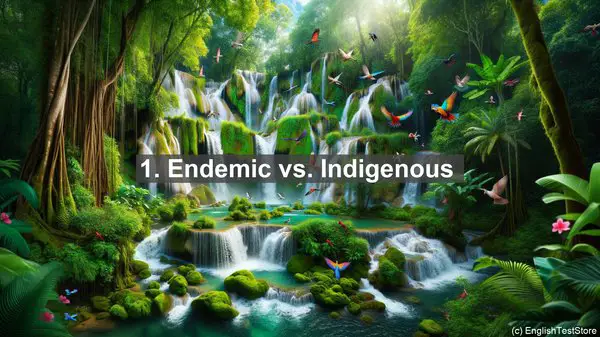Introduction
Welcome to today’s lesson on conservation biogeography. In this lesson, we’ll be focusing on the top 10 commonly confused words in this field. Understanding these words is crucial for effective communication and research. So, let’s dive in!
1. Endemic vs. Indigenous
The terms ‘endemic’ and ‘indigenous’ are often used interchangeably, but they have distinct meanings. ‘Endemic’ refers to a species that is exclusively found in a particular region, while ‘indigenous’ means a species that is native to a specific area. So, while all endemics are indigenous, not all indigenous species are endemic.
2. Habitat vs. Ecosystem
Although related, ‘habitat’ and ‘ecosystem’ are different concepts. A ‘habitat’ is the physical environment where a species lives, including its food, shelter, and other resources. On the other hand, an ‘ecosystem’ is a complex network of interactions between living organisms and their environment, encompassing multiple habitats.

3. Extinct vs. Extirpated
When we say a species is ‘extinct,’ it means that it no longer exists anywhere on Earth. However, ‘extirpated’ refers to a species that is extinct in a particular region or country but may still exist elsewhere. So, while the species is gone from a specific area, there is still hope for its survival globally.
4. Biodiversity vs. Species Richness
While ‘biodiversity’ and ‘species richness’ are related to the variety of life, they have different meanings. ‘Biodiversity’ encompasses not only the number of species in an area but also their genetic diversity and the variety of ecosystems. ‘Species richness,’ on the other hand, focuses solely on the number of different species present.
5. Keystone Species vs. Indicator Species
Both ‘keystone species’ and ‘indicator species’ play important roles in ecosystems, but in different ways. A ‘keystone species’ has a disproportionate impact on its environment, and its removal can lead to significant changes. An ‘indicator species,’ on the other hand, serves as a sign of the overall health or condition of an ecosystem.

6. Migration vs. Dispersal
‘Migration’ and ‘dispersal’ both involve the movement of organisms, but there are differences. ‘Migration’ refers to the regular, often seasonal, movement of species from one area to another. ‘Dispersal’ is the one-time movement of individuals away from their birthplace, often to establish new populations.
7. Fragmentation vs. Degradation
‘Fragmentation’ and ‘degradation’ are two threats to habitats, but they have distinct impacts. ‘Fragmentation’ occurs when a habitat is divided into smaller, isolated patches, which can disrupt species’ movements and gene flow. ‘Degradation’ refers to the deterioration of a habitat’s quality, often due to pollution or overexploitation.
8. Invasive vs. Non-native
An ‘invasive’ species is one that is not native to an area and has negative impacts on the local ecosystem, often outcompeting native species. A ‘non-native’ species, on the other hand, simply refers to a species that is not naturally found in a particular region, without implying any negative effects.
9. Conservation vs. Preservation
While both ‘conservation’ and ‘preservation’ involve protecting the environment, they have different approaches. ‘Conservation’ focuses on sustainable use and management of natural resources, often with an emphasis on human needs. ‘Preservation’ aims to protect nature in its pristine state, with minimal human intervention.
10. Restoration vs. Rehabilitation
When it comes to habitat or ecosystem recovery, ‘restoration’ and ‘rehabilitation’ are two strategies. ‘Restoration’ aims to bring a habitat back to its original, pre-disturbance condition, often through active measures like replanting. ‘Rehabilitation’ focuses on improving a degraded habitat, even if it can’t be fully restored.
